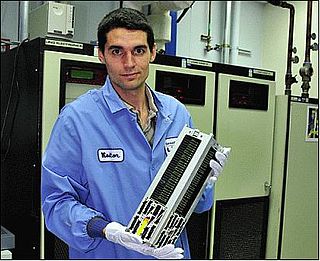
A CubeSat is a type of miniaturized satellite for space research that is made up of multiples of 10 cm × 10 cm × 11.35 cm cubic units. CubeSats have a mass of no more than 1.33 kilograms (2.9 lb) per unit, and often use commercial off-the-shelf (COTS) components for their electronics and structure. CubeSats are commonly put in orbit by deployers on the International Space Station, or launched as secondary payloads on a launch vehicle. Over 1000 CubeSats have been launched as of January 2019. Over 900 have been successfully deployed in orbit and over 80 have been destroyed in launch failures.

A small satellite, miniaturized satellite, or smallsat is a satellite of low mass and size, usually under 500 kg (1,100 lb). While all such satellites can be referred to as "small", different classifications are used to categorize them based on mass. Satellites can be built small to reduce the large economic cost of launch vehicles and the costs associated with construction. Miniature satellites, especially in large numbers, may be more useful than fewer, larger ones for some purposes – for example, gathering of scientific data and radio relay. Technical challenges in the construction of small satellites may include the lack of sufficient power storage or of room for a propulsion system.

SpaceX COTS Demo Flight 1 was the first orbital spaceflight of the Dragon cargo spacecraft, and the second overall flight of the Falcon 9 rocket manufactured by SpaceX. It was also the first demonstration flight for NASA's Commercial Orbital Transportation Services (COTS) program. The primary mission objectives were to test the orbital maneuvering and reentry of the Dragon capsule. The mission also aimed to test fixes to the Falcon 9 rocket, particularly the unplanned roll of the first stage that occurred during flight 1. Liftoff occurred on 8 December 2010 at 15:43 UTC.

KickSat was a small-satellite (femtosatellite) project inaugurated in early October 2011, to launch many very small satellites from a 3U CubeSat. The satellites have been characterized as being the size of a large postage stamp. and also as "cracker size". The mission launch was originally scheduled for late 2013 and was launched April 18, 2014.
The Technology Education Satellite (TechEdSat) program is a series of CubeSats built by San Jose State University and University of Idaho students in partnership with NASA's Ames Research Center. These satellites have tested communication technology for smallsats, and have contributed to the development of the Small Payload Quick Return (SPQR) concept.

SpaceX CRS-3, also known as SpX-3, was a Commercial Resupply Service mission to the International Space Station, contracted to NASA, which was launched on 18 April 2014. It was the fifth flight for SpaceX's uncrewed Dragon cargo spacecraft and the third SpaceX operational mission contracted to NASA under a Commercial Resupply Services contract.

Cygnus CRS Orb-3, also known as Orbital Sciences CRS Flight 3 or Orbital 3, was an attempted flight of Cygnus, an automated cargo spacecraft developed by United States-based company Orbital Sciences, on 28 October 2014. The mission was intended to launch at 6:22 PM that evening. This flight, which would have been its fourth to the International Space Station and the fifth of an Antares launch vehicle, resulted in the Antares rocket exploding seconds after liftoff.

Planet Labs, Inc. is an American private Earth imaging company based in San Francisco, CA. Their goal is to image the entirety of the planet daily to monitor changes and pinpoint trends. The company designs and manufactures Triple-CubeSat miniature satellites called Doves that are then delivered into orbit as secondary payloads on other rocket launch missions. Each Dove is equipped with a high-powered telescope and camera programmed to capture different swaths of Earth. Each Dove Earth observation satellite continuously scans Earth, sending data once it passes over a ground station. Together, Doves form the largest satellite constellation in the world that provides a complete image of Earth once per day at 3–5 m optical resolution. This is accomplished through a technique called a line scan, which allows for continuous, high resolution imagery due to the fact that this type of camera is not restricted to specific vertical resolution.

Cygnus CRS OA-5, also known as Orbital Sciences CRS Flight 5, was the seventh planned flight of the Orbital Sciences' unmanned resupply spacecraft Cygnus and its sixth flight to the International Space Station under the Commercial Resupply Services contract with NASA. The mission launched on October 17th, 2016 at 7:45 PM. Orbital and NASA jointly developed a new space transportation system to provide commercial cargo resupply services to the International Space Station (ISS). Under the Commercial Orbital Transportation System (COTS) program, Orbital designed and built Antares, a medium-class launch vehicle; Cygnus, an advanced maneuvering spacecraft; and a Pressurized Cargo Module which is provided by Orbital's industrial partner Thales Alenia Space.
Space Tethered Autonomous Robotic Satellite II or STARS-II, was a nanosatellite built by Japan's Kagawa University to test an electrodynamic tether in low Earth orbit, a follow-on to the STARS mission.

The NanoRacks CubeSat Deployer (NRCSD) is a device to deploy CubeSats into orbit from the International Space Station.

Mars Cube One was a Mars flyby mission launched on 5 May 2018 alongside NASA's InSight Mars lander mission. It consisted of two nanospacecraft, MarCO-A and MarCO-B, that provided a real-time communications link to Earth for InSight during its entry, descent, and landing (EDL) on 26 November 2018 - when InSight was out of line of sight from the Earth. Both spacecraft were 6U CubeSats, and the mission was a test of new miniaturized communications and navigation technologies. These were the first CubeSats to operate beyond Earth orbit, and aside from telecommunications they also tested CubeSats' endurance in deep space. On 5 February 2019, NASA reported that both the CubeSats had gone silent by 5 January 2019, and are unlikely to be heard from again. In August 2019, the CubeSats were honored for their role in the successful landing of the InSight lander on Mars.

Cygnus NG-11, previously known as CRS OA-11, was the twelfth flight of the Northrop Grumman robotic resupply spacecraft Cygnus and its eleventh flight to the International Space Station under the Commercial Resupply Services contract with NASA. The mission launched on 17 April 2019 at 4:46 PM EDT. This is the last mission from the extended CRS contract; follow-up missions are part of the CRS2 contract. NG-11 was also the first mission to load critical hardware onto Cygnus within the last 24 hours prior to launch, a new Antares feature.
Earth Escape Explorer (CU-E3) is a nanosatellite of the 6-Unit CubeSat format that will demonstrate long-distance communications while in heliocentric orbit.
Educational Launch of Nanosatellites (ELaNa) is an initiative created by NASA to attract and retain students in the science, technology, engineering and mathematics disciplines. The program is managed by the Launch Services Program (LSP) at NASA's Kennedy Space Center in Florida.

1KUNS-PF was the first Kenyan owned satellite to be launched into space. The cubesat was developed and assembled by the University of Nairobi. Technical support was provided by Japan's Aerospace Exploration Agency and it was launched from the International Space Station after being delivered to the station by a SpaceX Falcon 9 rocket.
IRVINE02 is an educational 1U CubeSat mission that gives high school students the experience of building, testing, and controlling a nano-satellite to develop interest and talent in the science and engineering fields. The mission features the second orbital ion electrospray thruster developed by Accion Systems. Beyond the thruster, IRVINE02 utilizes magnetorquers, deployable solar arrays, a GPS unit, and a miniaturized 1.4 Watt blue laser communication module to transmit pictures and data back to Earth. The magnetorquers and the laser are both developed by the Ecuadorian Space Agency. This laser made IRVINE02 the first 1U cubesat to fly with an orbit-to-ground laser communications device. It transmits data and pictures to the Earth much faster than radio.
Cygnus NG-12, previously known as CRS OA-12, is the thirteenth planned flight of the Northrop Grumman robotic resupply spacecraft Cygnus and its twelfth flight to the International Space Station under the Commercial Resupply Services contract with NASA. The mission is scheduled to launch on October 21, 2019 at 2:39 PM. This is the first launch of Cygnus under the CRS2 contract.



















